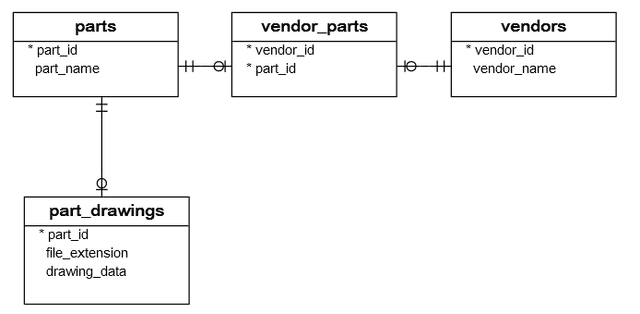PostgreSQL Python: Querying Data
Summary: in this tutorial, you will learn how to query data from the PostgreSQL tables in Python.
This tutorial picks up from where the Handling BLOB Data Tutorial left off.
The steps for querying data from a PostgreSQL table in Python
To query data from one or more PostgreSQL tables in Python, you use the following steps.
First, establish a connection to the PostgreSQL server by calling the connect() function of the psycopg2 module.
conn = psycopg2.connect(config)If the connection is created successfully, the connect() function returns a new Connection object; Otherwise, it throws a DatabaseError exception.
Next, create a new cursor by calling the cursor() method of the Connection object. The cursor object is used to execute a SELECT statement.
cur = conn.cursor()Then, execute a SELECT statement by calling the execute() method. If you want to pass values to the SELECT statement, you use the placeholder ( %s) in the SELECT statement and bind the input values when calling the execute() method:
cur.execute(sql, (value1,value2))After that, process the result set returned by the SELECT statement using the fetchone(), fetchall(), or fetchmany() method.
- The
fetchone()fetches the next row in the result set. It returns a single tuple orNonewhen no more row is available. - The
fetchmany(size=cursor.arraysize)fetches the next set of rows specified by thesizeparameter. If you omit this parameter, thearraysizewill determine the number of rows to be fetched. Thefetchmany()method returns a list of tuples or an empty list if no more rows are available. - The
fetchall()fetches all rows in the result set and returns a list of tuples. If there are no rows to fetch, thefetchall()method returns an empty list.
Finally, close the database connection by calling the close() method of the Cursor and Connection objects
cur.close()
conn.close()If you use context managers, you don’t need to explicitly call the close() methods of the Cursor and Connection objects.
Querying data using the fetchone() method
For the demonstration purposes, we will use the parts, vendors, and vendor_parts tables in the suppliers database:
 The following
The following get_vendor() function selects data from the vendors table and fetches the rows using the fetchone() method.
import psycopg2
from config import load_config
def get_vendors():
""" Retrieve data from the vendors table """
config = load_config()
try:
with psycopg2.connect(**config) as conn:
with conn.cursor() as cur:
cur.execute("SELECT vendor_id, vendor_name FROM vendors ORDER BY vendor_name")
print("The number of parts: ", cur.rowcount)
row = cur.fetchone()
while row is not None:
print(row)
row = cur.fetchone()
except (Exception, psycopg2.DatabaseError) as error:
print(error)
if __name__ == '__main__':
get_vendors()Output:
The number of parts: 8
(1, '3M Corp')
(2, 'AKM Semiconductor Inc.')
(3, 'Asahi Glass Co Ltd.')
(4, 'Daikin Industries Ltd.')
(5, 'Dynacast International Inc.')
(6, 'Foster Electric Co. Ltd.')
(8, 'LG')
(7, 'Murata Manufacturing Co. Ltd.')Querying data using the fetchall() method
The following get_parts() function uses the fetchall() method of the cursor object to fetch rows from the result set and display all the parts in the parts table.
import psycopg2
from config import load_config
def get_vendors():
""" Retrieve data from the vendors table """
config = load_config()
try:
with psycopg2.connect(**config) as conn:
with conn.cursor() as cur:
cur.execute("SELECT vendor_id, vendor_name FROM vendors ORDER BY vendor_name")
rows = cur.fetchall()
print("The number of parts: ", cur.rowcount)
for row in rows:
print(row)
except (Exception, psycopg2.DatabaseError) as error:
print(error)
if __name__ == '__main__':
get_vendors()The number of parts: 8
(1, '3M Corp')
(2, 'AKM Semiconductor Inc.')
(3, 'Asahi Glass Co Ltd.')
(4, 'Daikin Industries Ltd.')
(5, 'Dynacast International Inc.')
(6, 'Foster Electric Co. Ltd.')
(8, 'LG')
(7, 'Murata Manufacturing Co. Ltd.')Querying data using the fetchmany() method
The following get_suppliers() function selects parts and vendor data using the fetchmany() method.
import psycopg2
from config import load_config
def iter_row(cursor, size=10):
while True:
rows = cursor.fetchmany(size)
if not rows:
break
for row in rows:
yield row
def get_part_vendors():
""" Retrieve data from the vendors table """
config = load_config()
try:
with psycopg2.connect(**config) as conn:
with conn.cursor() as cur:
cur.execute("""
SELECT part_name, vendor_name
FROM parts
INNER JOIN vendor_parts ON vendor_parts.part_id = parts.part_id
INNER JOIN vendors ON vendors.vendor_id = vendor_parts.vendor_id
ORDER BY part_name;
""")
for row in iter_row(cur, 10):
print(row)
except (Exception, psycopg2.DatabaseError) as error:
print(error)
if __name__ == '__main__':
get_part_vendors()Output:
('Antenna', 'Foster Electric Co. Ltd.')
('Antenna', 'Murata Manufacturing Co. Ltd.')
('Home Button', 'Dynacast International Inc.')
('Home Button', '3M Corp')
('LTE Modem', 'Dynacast International Inc.')
('LTE Modem', '3M Corp')
('SIM Tray', 'AKM Semiconductor Inc.')
('SIM Tray', '3M Corp')
('Speaker', 'Daikin Industries Ltd.')
('Speaker', 'Asahi Glass Co Ltd.')
('Vibrator', 'Dynacast International Inc.')
('Vibrator', 'Foster Electric Co. Ltd.')Download the project source code
In this tutorial, we have learned how to select data from the PostgreSQL tables in Python using the fetchone(), fetchall(), and fetchmany() methods.